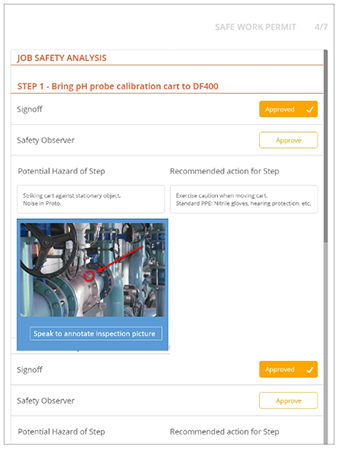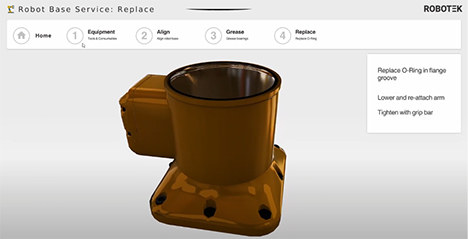Volume 24 | Issue 1
By David Brebner, Founder and CEO, Umajin
New, breakthrough workflow applications incorporating hands-free control, location technology, and visualization of key data are extending digital transformation to the frontline worker. By creating AI-enabled digital agents, activities that were previously high-touch experiences can be converted into touchless transactions, enhancing productivity and safety for a business’ employees and guests. With a voice-controlled workflow, digital interaction can occur on kiosks in public spaces, on mobile devices, or AR/VR headsets. Typical examples might include facility or building check-ins, safety work permit processes, and task and safety trainings. By offering a voice-controlled option, interactions can take place at a safe distance while also improving efficiency by providing added health or security screening options.
COVID-19 has caused many organizations to implement policies for checking the health status of individuals entering a facility as well as managing the use of meeting rooms and other shared spaces to ensure that social distancing requirements are maintained. While some of these processes may be discontinued as vaccinations reach the majority of the population later in 2021 and beyond, the value of public health protocols such as screening for infection has been established and will likely continue in modified form post-pandemic.
The SmartAccess kiosk reduces the cost of managing building access while providing systematic tracking of health status or other key security-related metrics. It also helps establish confidence in the safety of the facility for both employees and visitors.
The digital avatar and voice interaction is intuitive for both employees and visitors to use and can provide a very personalized, positive experience. Because these solutions can be remotely managed and easily updated, they can be easily adjusted as environmental or public safety regulations change – allowing for a quick conversion to an exclusively digital receptionist/building access control solution when needed. And as COVID restrictions evolve, these solutions allow for additional screening and tracking components if health or security risks become more prevalent.
Kiosk check-ins can be made even quicker by using an ID badge, facial recognition, a partner smartphone app or even a pre-shared QR code for visitors. Kiosks can also easily incorporate basic health checks such as temperature and pulse ox – flagging any potential health risks for further screening. Other testing/health status data can be added as needed.
The kiosk can also direct employees or visitors to the appropriate location in the facility, with the aid of the partner smartphone app. This can take into account the specific locations the user is intended to visit or avoid based on security, fire safety, and social distancing requirements.
Many manufacturing and processing facilities use paper-based safe work permit processes to manage the risk of potentially hazardous activity like lock out/tag out or line break permits. This type of process can be implemented on a rugged tablet and eventually to AR headgear. Since workers are often wearing protective gear, voice-controlled processes can be more efficient on either type of device.
The tablet-based process also allows for improvements to the information captured including photos with voice dictation and drawings of annotations to reduce data entry overhead. Tablets can be registered to a specific user with biometric identification allowing for sign off and authorization to be efficiently performed on-site with a user, location and timestamp recorded.
A dashboard can be provided to show that safe work permits are completed and in progress, providing insights into the opportunities for broader plant and process improvements.

The ability to train employees with more visually stimulating and memorable materials will have a significant impact on retention. Traditional classroom training can have limited effectiveness for many segments of employees. Many classrooms or online trainings can be relatively passive, and there is the risk that employees neither enjoy the experience nor retain much of the content that is presented. While one-on-one training or coaching on the line with an experienced technician can be effective, these approaches are also very expensive.
The virtual reality methods that have long been used to train airline pilots can readily be incorporated into voice-controlled applications running on kiosks, tablets or AR/VR headsets, providing low cost but effective training for many complex technical tasks. The training application is designed around an optimal sequential work process as executed by an experienced technician. CAD files displaying machinery and components can easily be incorporated to provide 3D visualizations of the actual process, annotated with a description of the required materials, safety precautions, and steps used for assembly, disassembly, or service.
The trainee can control the steps of the process by voice, allowing the pace to reflect the rate at which the individual can absorb the material. The trainee can also request to repeat a step or back up several process steps if they encounter any material they don’t understand initially.
The increasing availability of comfortable, cost effective AR headgear will allow the instruction to be overlayed on the actual equipment and components, and high-fidelity 3D renderings of the equipment on a tablet, kiosk, or VR headset can also create an effective training environment.

These are just three of the most obvious use cases where touchless workflow applications can greatly improve the efficiency and safety of frontline work. Many more will be developed as the technology becomes more ubiquitous. New development platforms are making the development process of these applications increasingly cost effective and making them more widely available across a broader range of endpoint devices. And this surely will become the trend – as digital agents and workflow applications that provide intuitive, hands-free, visual information everywhere will accelerate the completion of a company’s digital transformation journey by tackling the last-mile problem of enabling frontline workers.

David Brebner is a serial entrepreneur operating in the software development, data visualization and image processing spaces. In addition to founding Umajin, David founded both Fingertapps and Unlimited Realities. David’s companies have developed software for many of the world’s best-known companies like Toyota, Dell, Intel, HP, Lenovo and ASUS. David’s areas of technical proficiency include real-time computer graphics, language design, systems architecture, multi-touch, computer vision, image compression, database design, full-text indexing, software architecture and user interface design.
In this episode, I sat down with Beejan Giga, Director | Partner and Caleb Emerson, Senior Results Manager at Carpedia International. We discussed the insights behind their recent Industry Today article, “Thinking Three Moves Ahead” and together we explored how manufacturers can plan more strategically, align with their suppliers, and build the operational discipline needed to support intentional, sustainable growth. It was a conversation packed with practical perspectives on navigating a fast-changing industry landscape.